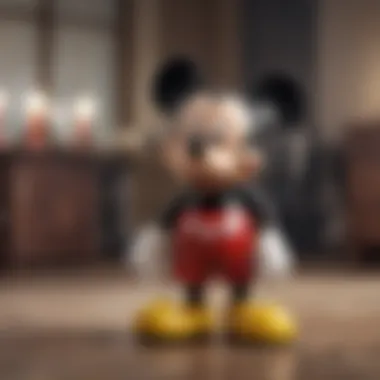Mickey Mouse: Cultural Legacy in Domestic Settings


Intro
Mickey Mouse stands as an iconic figure within the cultural landscape, with a prominent role in many households around the world. First introduced in 1928, this character has evolved significantly, reflecting and influencing the lives of those who grew up with him. This article delves into the various dimensions of Mickey Mouse's presence in domestic life, examining his origins, evolution, and lasting impact on childhood experiences.
The exploration centers not just on the character's history but also on how he has shaped cultural discussions and family memories, particularly within the environment of the home. In doing so, we will highlight the various aspects that contribute to Mickey Mouse's esteemed position in popular culture and family life.
Artist Profile
Biography and Background
Mickey Mouse was created by Walt Disney and Ub Iwerks. His first public appearance was in the animated short "Plane Crazy" in 1928. The character quickly gained popularity, becoming a symbol of joy and optimism in a society facing economic hardship during the Great Depression. From a simple animated figure, Mickey transformed into a multifaceted icon representing not only entertainment but also hope and resilience.
Over the decades, Mickey Mouse has starred in numerous films, television shows, and merchandise, solidifying his status as a beloved character. His image has evolved, adapting to the changing tastes of audiences and the cultural landscape, but he has consistently embodied the spirit of creativity and adventure.
Major Influences and Inspirations
Mickey Mouse draws influence from various cultural elements. Walt Disney's vision was significantly shaped by his early experiences in the entertainment industry. The animation style at that time and influences from silent films also played a critical role in shaping Mickey’s character and persona.
Further, the sociocultural dynamics during his creation triggered Mickey's appeal. The optimism of the post-war era, the rise of consumer culture, and the advent of television during the 1950s contributed to his lasting popularity.
The Domestic Impact of Mickey Mouse
Mickey Mouse has established himself as more than an entertainment figure. He has become a staple in many households, often linked to childhood experiences. From toys to bedding, numerous products feature his image, making him a familiar sight in homes.
The emotional resonance of Mickey Mouse is noteworthy, as he evokes memories of family moments spent watching cartoons or visiting theme parks. This connection strengthens familial bonds, enriching conversations and shared experiences.
"Mickey Mouse represents the innocence of childhood and the ever-lasting joy of family connections."
Ending
In summary, Mickey Mouse transcends mere entertainment, becoming a vital part of cultural and social discussions, particularly within households. Through his evolution and adaptation, he remains relevant in an ever-changing world, impacting generations of children and adults alike. This exploration aims to highlight how Mickey Mouse shapes not only individual experiences but also broader cultural narratives that continue to flourish within the domestic realm.
Prolusion to Mickey Mouse
Mickey Mouse, a character that has become emblematic of entertainment, childhood, and innocence, calls for a thorough examination. Understanding his origins, character design, and historical significance is paramount to grasping his impact on culture and families. This section sets the stage for exploring how Mickey Mouse transcends his role as just a cartoon character and emerges as a cultural icon deeply embedded in homes around the globe.
Historical Context
Mickey Mouse was introduced to the world in 1928, created by Walt Disney and Ub Iwerks. This period marked a significant moment in animation history. The character was born out of necessity, stemming from Disney's loss of rights to Oswald the Lucky Rabbit. Mickey Mouse not only filled that void but also ushered in a new era of animation characterized by innovative techniques and storytelling.
The first appearance of Mickey Mouse was in the short film "Plane Crazy," but it was "Steamboat Willie," released later in the same year, that gained widespread acclaim due to its synchronized sound. This achievement positioned Mickey as a leader in animation, capturing the attention and hearts of audiences. The socio-economic climate of the late 1920s and early 1930s, marked by the Great Depression, played a crucial role in popularizing Mickey. He offered a sense of hope and happiness during hard times, ultimately becoming a symbol of resilience.
Character Design and Creation
The character design of Mickey Mouse is minimalist yet effective. His large round ears and cheerful face easily connect with children and adults alike. These features were carefully chosen to ensure maximum visual appeal and recognizability. The design process involved trials with various character personalities, but Mickey’s charm lay in his relatability—a mouse with human traits.
Mickey was initially portrayed with mischievous qualities, often finding himself in reckless situations. Over time, his character evolved into an emblem of positivity and virtue, championing friendship, adventure, and humor. This transition underscores the adaptability of Mickey's persona, which has allowed him to retain relevance across generations.
Through cultural shifts and technological advancements, Mickey Mouse remains a definitive icon in both animation and household environments. His presence serves as an example of how a well-crafted character can resonate through history, shaping family dynamics and entertainment traditions for decades.


Mickey Mouse's Role in Family Homes
Mickey Mouse occupies a unique place in family homes around the world. His presence is ubiquitous in various forms of media, merchandise, and entertainment options. From early cartoons to contemporary animated series, he embodies a spirit that resonates with children and adults alike. Analyzing Mickey's role in these homes reveals how he not only entertains but also influences family dynamics and childhood development.
Presence in Family Entertainment
The presence of Mickey Mouse in family entertainment is significant. Since his debut in 1928, he has become an essential figure in animated films, television shows, and theme park experiences. His character often serves as a bridge between different generations, allowing parents and children to share moments of joy together.
Shows like "Mickey Mouse Clubhouse" effectively engage young viewers with interactive storytelling. The educational elements often integrated into these programs aid in early childhood learning while ensuring that entertainment remains at the forefront. As a result, Mickey's role in family viewing experiences cultivates not only entertainment but also enrichment, making him an indispensable part of family life.
Symbol of Joy and Playfulness
Mickey Mouse is synonymous with joy and playfulness. His cheerful disposition and animated antics create a sense of happiness that many families embrace. This positive representation can foster emotional well-being among children, who often look up to him as a role model.
The character encourages imaginative play, which is vital for childhood development. Parents often witness their children engaging in creative scenarios inspired by Mickey's adventures, whether it's reenacting scenes or creating their own stories. In this way, Mickey is more than just a character; he becomes a catalyst for creativity and fun within the domestic space.
Parental Perspectives
Parents harbor generally positive views of Mickey Mouse in their homes. They appreciate his wholesome image, which aligns with their values of providing safe and enriching entertainment. Mickey often acts as a tool for parents to teach essential life lessons, including kindness, friendship, and perseverance.
However, some concerns also arise regarding commercialization and branding. As products bearing Mickey’s likeness permeate homes, parents ponder the balance between entertainment and consumerism. Some express desire for better quality content and less emphasis on marketing than on the stories themselves. These discussions reveal that Mickey represents not just a character, but a larger narrative about the intersection of childhood, joy, and the complexities of modern family life.
"Mickey Mouse is not merely a cartoon; he is a representation of joy cherished across generations, often reflecting the values that families hold dear."
In summary, Mickey Mouse's role in family homes goes beyond entertainment; he embodies learning, joy, and cultural heritage. Across generations, Mickey serves as both a source of fun and a guide for important life lessons.
The Evolution of Mickey Mouse
The transformation of Mickey Mouse over the years marks a significant chapter in the narrative of American pop culture. This section delves into how he has adapted to the changing socio-cultural landscape. Such evolution is crucial for understanding his enduring relevance. It reflects broader trends in media and consumer behavior. Considering Mickey's journey helps to highlight the character's role not just as entertainment, but as a mirror of society's values and aspirations.
From Silent Films to Modern Media
Mickey Mouse debuted in a time when film was still finding its voice. His first significant appearance was in the silent film Steamboat Willie in 1928. This film was one of the first to synchronize sound with animation. Even then, Mickey was a charming figure, capturing the audience's attention right away.
As technology progressed, so did the methods of storytelling. Transitioning from classic black-and-white animations to vibrant technicolor films, Mickey reflected these advancements. The 1930s and 1940s saw him in feature films like Fantasia and Mickey's Christmas Carol. This period solidified his place in cinema history.
Now, in the digital age, Mickey appears across various platforms. He participates in video games, streaming services, and virtual reality experiences. His ability to adapt keeps him relevant for new generations.
Changes in Character Portrayal
Mickey Mouse's character portrayal has notably evolved over the decades. Originally depicted as mischievous and somewhat rebellious, he gradually transformed into a more wholesome character. This shift aligns with changing societal norms.
In the early years, Mickey depicted a sense of adventure and trouble-making, often getting into antics that parents might deem inappropriate today. However, as societal expectations shifted, so too did his character. He became a model of positivity and problem-solving, aiming to be a good influence for children.
This transition is particularly essential in the context of family entertainment. Mickey now embodies values like friendship, kindness, and optimism. He participates in educational themed programming, enhancing his role as a positive figure.
Merchandising Impact
The evolution of Mickey Mouse is also greatly tied to his merchandising strategy. What began with simple toys and collectibles in the 1930s has expanded into a massive global empire.
Mickey's merchandise includes:


- Toys and apparel
- Home goods
- Accessories
- Video games
- Theme park attractions
Each of these products builds a connection between Mickey and the consumer. This connection reinforced Mickey's presence in households around the world. With every new product, Mickey's image evolves and rejuvenates, ensuring his continued relevance.
Merchandising doesn’t just benefit the brand. It shapes how fans interact with Mickey. Through clothing, toys, and experiences, fans can express their admiration for the character. This relationship fosters loyalty and connectivity, allowing Mickey to become more than just an animated character.
"Mickey Mouse is a symbol of what is creatively possible, transcending simple entertainment to become a multifaceted icon that continues to engage audiences worldwide."
Mickey Mouse in Popular Culture
Mickey Mouse has transcended his origins as a simple cartoon character to become a significant figure in popular culture. His influence reaches far beyond animation, resulting in a lasting impact on various aspects of global entertainment and social discussions. Understanding Mickey’s role in popular culture is essential to appreciating how he embodies themes of joy, resilience, and creativity.
Cultural References and Appearances
Mickey Mouse appears across different media, influencing countless creators. He has been referenced in movies, television shows, and music, becoming a symbol recognized worldwide.
- In film, movies like Who Framed Roger Rabbit seamlessly blend Mickey with other famous characters.
- Television often features Mickey as a guest in various forms. For instance, in The Simpsons, Mickey is portrayed in a humorous light, reflecting society's view of the character and his brand.
Mickey's appearances frequently serve to underline cultural themes. His character represents not just entertainment but also nostalgia and innocence. Engagement with Mickey in pop culture reflects how society cherishes childhood memories while navigating contemporary issues.
"Mickey Mouse is more than a character; he is a cultural icon whose presence signifies collective memory across generations."
Influence on Contemporary Artists
Mickey Mouse has inspired many contemporary artists, serving as a muse for both established and emerging talents. Artists like Andy Warhol and Takashi Murakami incorporate Mickey into their works to explore themes related to commercialism, consumer culture, and art's relationship with mass media.
Furthermore, some artists push boundaries by transforming Mickey into commentary on social issues. For instance:
- Street artists use Mickey's image to discuss consumerism and capitalism.
- Installation artists consider how Mickey reflects identity and globalization.
This creative reinterpretation keeps Mickey relevant in discussions about art and culture today. By bridging the gap between past and present, artists continue to engage audiences with new perspectives on a familiar figure. His image, often seen in galleries and exhibitions, prompts viewers to reconsider the implications of iconic symbols in a constantly evolving cultural landscape.
Mickey Mouse and Childhood Development
Mickey Mouse plays an important role in the development of children. This character is not just a figure in cartoons but becomes a vehicle for values that shape formative years. The influence of Mickey Mouse extends beyond mere entertainment, fostering essential skills and attitudes in young minds. Understanding this significance enhances our insight into both the character and the impact on childhood experiences.
Imaginative Play and Creativity
Mickey Mouse inspires imaginative play in children. When children engage with Mickey through toys, shows, or books, they enter a vivid realm where creativity can flourish. This form of play allows children to explore scenarios, express ideas, and challenge their own limitations.
- Role-Playing: Kids often emulate Mickey's adventures, encouraging them to practice problem-solving and social skills. This role-playing aspect allows children to navigate their worlds more effectively.
- Diversity of Stories: Over decades, Mickey has been featured in diverse stories that teach children about teamwork, friendship, and honesty. Each narrative serves as a springboard for ideas, pushing children to create their own imaginative scenarios.
The power of imaginative play is that it promotes critical thinking, adaptability, and empathy in young viewers, essential qualities for later life.
Education through Entertainment
Mickey Mouse also serves as a tool for educational purposes. Certain programs featuring Mickey prioritize learning. They combine entertainment with educational content. This unique blend keeps children engaged, making learning feel like play rather than a chore.
- Basic Skills: Shows often introduce concepts like numbers, letters, and shapes, seamlessly integrating them into the storyline. This approach enhances retention through repetition in an enjoyable format.
- Moral Lessons: Episodes frequently involve lessons aimed at character building. Mickey and friends often encounter challenges that require ethical decisions, subtly teaching children about honesty and kindness.


Critical Reception and Controversies
Critical reception and controversies surrounding Mickey Mouse are essential topics in understanding the character's impact on culture and media. This exploration invites a deeper look at issues beyond entertainment, revealing how Mickey embodies broader societal concerns. Examining these disputes allows for a critical engagement with the character, especially regarding matters of representation and cultural significance. By delving into both cultural appropriations and gender representation, we can appreciate how Mickey Mouse embodies conflicting views, leading to important discussions about identity and ethics within popular culture.
Cultural Appropriation and Critique
Cultural appropriation has become a significant concern in recent years, prompting critiques of media portrayals, including that of Mickey Mouse. The character was originally conceived during a time when racial and cultural representations were not scrutinized as they are today. This raises questions about how Mickey has evolved or failed to evolve in the face of changing societal norms.
Critics argue that some of Mickey's portrayals may perpetuate stereotypes, particularly when integrated with cultural imagery from marginalized communities. For instance, instances where he dons attire or adopts mannerisms associated with different cultures can be viewed as trivializing complex cultures, leading to accusations of appropriation. While some argue that this fusion enhances character relatability, others emphasize the necessity of mindful representations that respect cultural origins. This debate highlights a pivotal shift in audience expectations and the imperative for modern-day creators to navigate these cultural sensitivities carefully.
"As Mickey Mouse continues to be a relevant figure, it becomes crucial to balance creativity and cultural respect, ensuring that the character's engagement remains authentic and respectful."
Gender Representation Issues
Another critical area of focus is the portrayal of gender through Mickey Mouse and related characters. Historically, many animated characters, including Mickey's companions, have been inscribed with traditional gender roles. The female characters, like Minnie Mouse, often reflect stereotypes of femininity, which can limit the representation of women's complexities.
Despite efforts to modernize these representations, there remains an observable dichotomy in how male and female characters are portrayed. Mickey often embodies active, heroic traits, while female characters may be depicted as supportive or secondary figures. Critics point out that this dynamic can inadvertently reinforce dated societal norms around gender roles.
Recent attempts to diversify character traits and relationships within the Disney universe highlight an ongoing commitment to gender equality. Understanding how Mickey and his companions fit into evolving narratives not only sheds light on past limitations but also points to the potential for more progressive representations in the future.
The Future of Mickey Mouse
As Mickey Mouse continues to be an iconic figure, understanding his future remains crucial. The way Mickey adapts to shifting cultural landscapes will determine his relevance in the years to come. This section examines key elements that will guide Mickey Mouse's evolution, focusing on technological integration and sustainability in branding. These factors are not only important for his consistent presence but also essential for ensuring he resonates with future generations.
Technological Integration
The impact of technology on entertainment is undeniable. Mickey Mouse must adapt to new platforms and methods of storytelling. As families increasingly turn to streaming services, social media, and interactive platforms for entertainment, Mickey's ability to thrive in these environments is vital.
- Adaptability: Mickey Mouse has to adjust his character and stories for various formats. Short clips on platforms like TikTok or Instagram can keep him relevant in a fast-paced digital world.
- Interactive Experiences: With the rise of virtual and augmented reality, Mickey can offer audiences immersive experiences. This integration can create deeper connections with fans.
- Global Reach: Technology allows characters to enter international markets. Mickey Mouse must embrace localization while maintaining his core identity.
In the context of education, technology provides new ways to engage children. Interactive games featuring Mickey can teach valuable skills, thus reinforcing his role in childhood development. Developing applications that make educational content entertaining will further solidify Mickey's relevance in this domain.
Sustainability in Branding
Sustainability is becoming a significant consideration for consumers. As societal values shift toward environmental consciousness, brands must align with these principles. Mickey Mouse is not exempt from this trend; his future hinges on embracing sustainable practices both behind the scenes and in customer touchpoints.
- Eco-friendly Merchandise: Production of Mickey-themed products should focus on sustainable materials. Using recyclable or biodegradable materials can appeal to eco-conscious consumers.
- Community Engagement: Participating in environmental initiatives helps improve the brand's image. Collaborating with organizations focused on conservation fosters goodwill and demonstrates a commitment to the planet.
- Responsible Storytelling: Stories told through Mickey Mouse's adventures can reflect themes of sustainability and conservation. This narrative shift can inspire young audiences to respect the environment and become responsible stewards of the Earth.
Ultimately, the future of Mickey Mouse involves the careful balancing of tradition with innovation. Embracing technology and sustainability not only keeps him relevant but also positions him as a proactive figure that future generations can admire. The character's legacy will be shaped by how effectively these elements are woven into the fabric of his essence.
Epilogue: Mickey Mouse's Enduring Legacy
Mickey Mouse continues to hold a significant place in our cultural landscape. This conclusion connects various themes from earlier discussions, emphasizing how Mickey acts not just as a character but as an emblem of broader social values. His enduring legacy reflects the intersection of entertainment, education, and family dynamics.
Cultural Resonance
Mickey Mouse's character resonates across multiple generations. From his humble beginnings in the 1920s to his present-day persona, Mickey embodies themes of hope, joy, and resilience. His presence in homes is often a central aspect of family entertainment. Children and adults alike have formed a deep-seated connection with Mickey Mouse through animated series, movies, and theme parks. This cultural resonance is apparent in how Mickey is often cited as a comfort during troubles or celebrations. The character's ability to invoke nostalgia speaks volumes about his role in shaping our memories, serving as a touchstone for collective experiences.
"Mickey Mouse represents more than just entertainment; he is a reflection of cultural ideals and family values passed from generation to generation."
This impact extends beyond the screen. Mickey appears in children's books, educational material, and various merchandise, solidifying his role in early childhood experiences. Knowing he can be a supportive figure helps children feel connected and understood, fostering positive emotional development.
Implications for Future Generations
Looking toward the future, Mickey Mouse holds potential for even greater relevance. As the landscape of entertainment continues to evolve, so will Mickey's adaptability. With advances in technology, including augmented reality and interactive media, Mickey can serve to engage children in new ways. He might act as an educational ally in navigating complex topics, such as diversity and environmental sustainability.
Furthermore, as family dynamics change, Mickey will likely adjust to reflect new social norms. His representation of inclusion and joy can continue to help families bond over shared experiences. By incorporating modern narratives while retaining core characteristics, Mickey Mouse can impart values that resonate with future generations.







